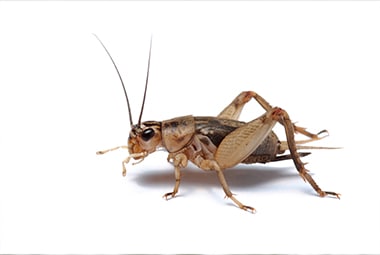
Of the 900 known species of crickets, 100 live in the United States. These insects derive their name from the chirping noise they make, which sounds like “crik” – “et” to many.
While crickets are viewed as nuisance pests by many, there are also cultural associations with these insects. In China and Zambia, crickets are thought to bring good luck. In Barbados, they signal impending wealth. In Brazil, they are believed to predict rain, pregnancy, illness, or sudden income. In some cultures, they are harbingers of death. High in protein, crickets are fried and eaten by humans in some parts of Asia. They are also bred and kept as pets by people all over the world.
What do crickets look like?
Crickets range from 1/2” to 2” in length, with the house cricket on the smaller side and the field cricket about an inch long. Depending on species, they can be green, red, brown, or black and may have markings of a different color. The body of a cricket consists of a head, thorax, abdomen, six legs, two long antennae (called feelers), two pairs of legs, and two sets of wings that lay flat against the body. Crickets’ bodies are covered in a hard exoskeleton with openings called spiracles through which they breathe. They have compound eyes with many lenses, giving them excellent vision. The rear hind wings are longer than the front forewings, though crickets do not fly. The cricket’s hind legs are longer than the front, making them capable of jumping 20 times their body length.
Crickets hatch from eggs to become nymphs and then grow into adults. The mating ritual is initiated by the male cricket, who rubs its wings together to create a chirping sound to attract the female. After mating, the female lays up to 400 eggs in soil or plant material, where they stay until the weather grows warm. When they hatch, the eggs become nymphs, which look like smaller versions of adults without wings. The nymphs, or baby crickets, will molt multiple times as they develop into adults, which typically takes about three months. The average life expectancy of most adult crickets is 1-3 months, though they may live as long as a year in the wild.
What are the unique characteristics of crickets?
Crickets use their antennae to find food and detect motion in potential prey. They are omnivores who will eat just about anything. Crickets consume other insects and plant-based items, especially those that are decaying. However, these insects are opportunistic and will eat paper, fresh fruit and vegetables, fungi, and fabric. Some species also demonstrate cannibalistic tendencies, feeding on other weak or injured crickets.
Crickets communicate by rubbing their wings together to create a chirping sound. Chirping, also called stridulation, is most often done by males to attract females or ward off other males. Aside from mating, crickets tend to be solitary animals, living alone.
What are the habits of crickets?
Crickets are nocturnal insects, becoming more active at night (which is why you tend to hear chirping at bedtime). They prefer warmth over the cold and will hibernate or seek shelter indoors during the winter. Cricket eggs hatch in the spring, becoming nymphs and adults over the summer and early fall. During this time, crickets are most visible and abundant.
Where are crickets commonly found?
Crickets live on every continent except Antarctica, with the most species found in tropical locales. Outdoors, crickets live under rocks, logs, leaves, grass, soil, and debris. Some types, especially the aptly-named house cricket, prefer to live indoors where they seek out cracks and crevices for shelter and protection of their eggs.
What are the risks of crickets?
Because they eat other insects, crickets are an asset to your property when outdoors. However, when they find their way into your home, crickets can be both disruptive and destructive. House crickets will eat fruit, vegetables, clothing, paper, linens, and other items they find around your home. Their chirping, which occurs at night, can also be loud enough to disrupt or prevent sleep.

